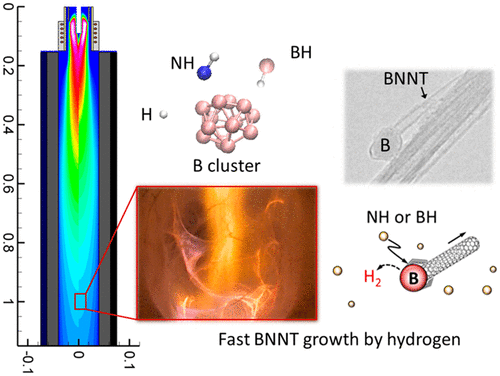Our official English website, www.x-mol.net, welcomes your feedback! (Note: you will need to create a separate account there.)
Role of Hydrogen in High-Yield Growth of Boron Nitride Nanotubes at Atmospheric Pressure by Induction Thermal Plasma
ACS Nano ( IF 17.1 ) Pub Date : 2018-01-10 00:00:00 , DOI: 10.1021/acsnano.7b08708 Keun Su Kim 1, 2 , Martin Couillard 3 , Homin Shin 1 , Mark Plunkett 1 , Dean Ruth 1 , Christopher T. Kingston 1 , Benoit Simard 1
ACS Nano ( IF 17.1 ) Pub Date : 2018-01-10 00:00:00 , DOI: 10.1021/acsnano.7b08708 Keun Su Kim 1, 2 , Martin Couillard 3 , Homin Shin 1 , Mark Plunkett 1 , Dean Ruth 1 , Christopher T. Kingston 1 , Benoit Simard 1
Affiliation

|
We recently demonstrated scalable manufacturing of boron nitride nanotubes (BNNTs) directly from hexagonal BN (hBN) powder by using induction thermal plasma, with a high-yield rate approaching 20 g/h. The main finding was that the presence of hydrogen is crucial for the high-yield growth of BNNTs. Here we investigate the detailed role of hydrogen by numerical modeling and in situ optical emission spectroscopy (OES) and reveal that both the thermofluidic fields and chemical pathways are significantly altered by hydrogen in favor of rapid growth of BNNTs. The numerical simulation indicated improved particle heating and quenching rates (∼105 K/s) due to the high thermal conductivity of hydrogen over the temperature range of 3500–4000 K. These are crucial for the complete vaporization of the hBN feedstock and rapid formation of nanosized B droplets for the subsequent BNNT growth. Hydrogen is also found to extend the active BNNT growth zone toward the reactor downstream, maintaining the gas temperature above the B solidification limit (∼2300 K) by releasing the recombination heat of H atoms, which starts at 3800 K. The OES study revealed that H radicals also stabilize B or N radicals from dissociation of the feedstock as BH and NH radicals while suppressing the formation of N2 or N2+ species. Our density functional theory calculations showed that such radicals can provide faster chemical pathways for the formation of BN compared with relatively inert N2.
中文翻译:

氢在大气压下感应热等离子体在氮化硼纳米管高产率生长中的作用
我们最近展示了通过使用感应热等离子体直接从六角形BN(hBN)粉末可扩展制造氮化硼纳米管(BNNT),其高产率达到了20 g / h。主要发现是氢的存在对于BNNTs的高产率生长至关重要。在这里,我们通过数值模型和原位光发射光谱法(OES)研究了氢的详细作用,并揭示了氢可显着改变热流体场和化学途径,从而有利于BNNTs的快速生长。数值模拟表明提高了颗粒的加热和淬灭速率(〜10 5K / s)是由于氢在3500–4000 K的温度范围内具有很高的热导率。这对于hBN原料的完全汽化以及为随后的BNNT生长快速形成纳米级B滴至关重要。还发现氢气使活性BNNT生长区向反应器下游延伸,通过释放3800 K开始的H原子重组热,使气体温度保持在B凝固极限(〜2300 K)以上。 H自由基还可以稳定原料中B或N自由基,使其不分解为BH和NH自由基,同时抑制N 2或N 2 +的形成。物种。我们的密度泛函理论计算表明,与相对惰性的N 2相比,此类自由基可为BN的形成提供更快的化学途径。
更新日期:2018-01-10
中文翻译:

氢在大气压下感应热等离子体在氮化硼纳米管高产率生长中的作用
我们最近展示了通过使用感应热等离子体直接从六角形BN(hBN)粉末可扩展制造氮化硼纳米管(BNNT),其高产率达到了20 g / h。主要发现是氢的存在对于BNNTs的高产率生长至关重要。在这里,我们通过数值模型和原位光发射光谱法(OES)研究了氢的详细作用,并揭示了氢可显着改变热流体场和化学途径,从而有利于BNNTs的快速生长。数值模拟表明提高了颗粒的加热和淬灭速率(〜10 5K / s)是由于氢在3500–4000 K的温度范围内具有很高的热导率。这对于hBN原料的完全汽化以及为随后的BNNT生长快速形成纳米级B滴至关重要。还发现氢气使活性BNNT生长区向反应器下游延伸,通过释放3800 K开始的H原子重组热,使气体温度保持在B凝固极限(〜2300 K)以上。 H自由基还可以稳定原料中B或N自由基,使其不分解为BH和NH自由基,同时抑制N 2或N 2 +的形成。物种。我们的密度泛函理论计算表明,与相对惰性的N 2相比,此类自由基可为BN的形成提供更快的化学途径。



























 京公网安备 11010802027423号
京公网安备 11010802027423号